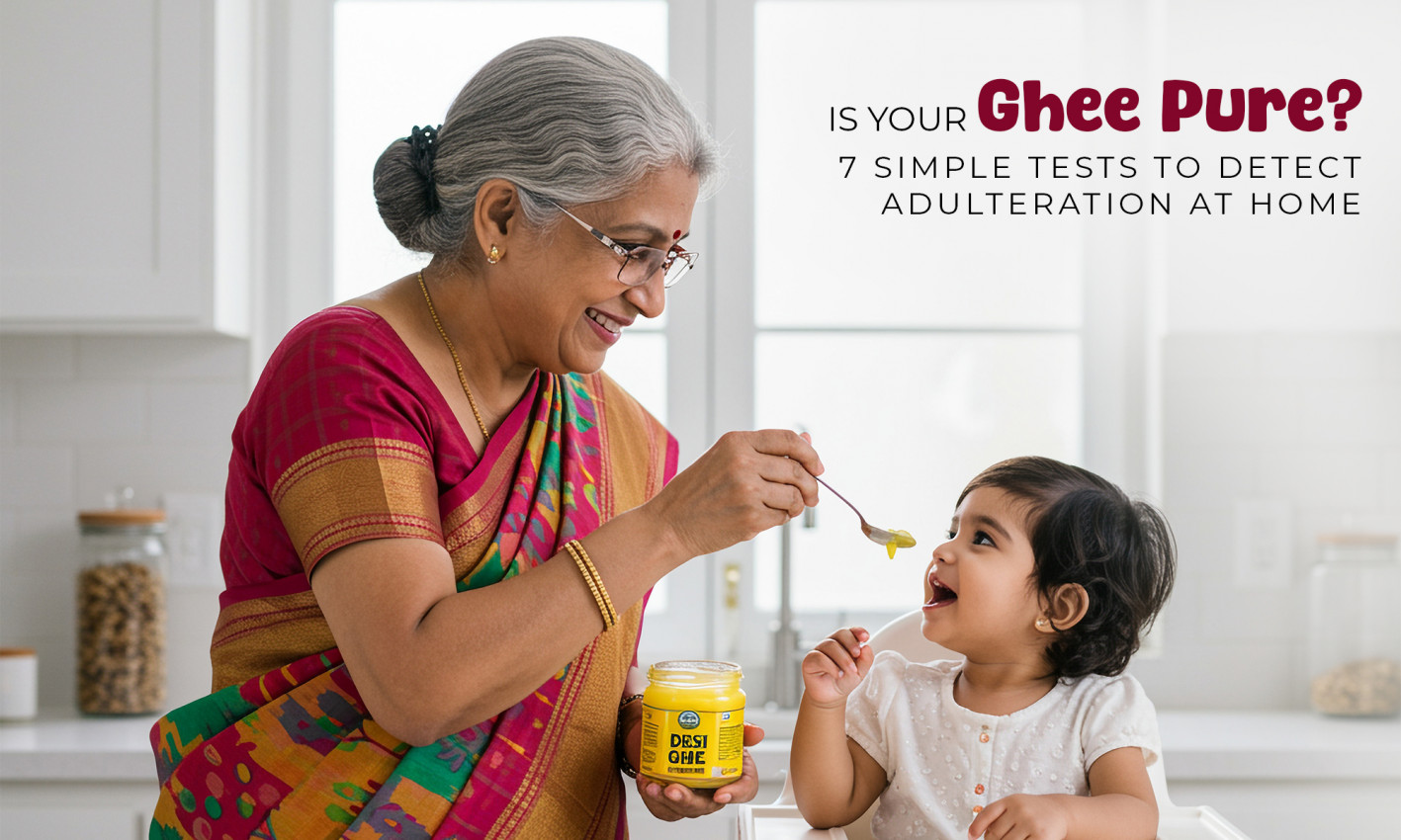
oAyurveda calls this age-old elixir “Liquid Gold,” and India has been consuming this since 1500 BC!
We are talking about our own Pure Ghee, a staple in many Indian households, which is renowned for its rich flavor and numerous health benefits.
Ghee is highly esteemed in the ancient Indian system of medicine for its anti-inflammatory properties and its ability to aid digestion and promote mental well-being.
However, the market today is full of adulterated ghee, which not only compromises the taste but also poses significant health risks.
In this blog, we tell you about the 7 simple tests you can do at home to avoid the health risks of adulterated ghee and get the maximum nutrition.
Why Ghee Purity Matters
Desi cow ghee is a rich source of essential fatty acids, vitamins A, D, E, and K, and antioxidants.
Ayurveda prioritizes the importance of ghee purity, which supports digestion, boosts immunity, and promotes overall well-being.
Conversely, adulterated ghee often contains harmful substances like vanaspati (hydrogenated fats), starch, or synthetic colors, which can lead to digestive issues, heart problems, and other health concerns.
7 Easy Home Tests to Check Ghee Purity
If you’re concerned about the health risks of adulterated ghee, then here are seven tests to test ghee at home using everyday items.
1. Palm Test (Melting Point Test)

In this pure ghee test at home, take a small spoonful of ghee and place it on your palm. Observe how quickly it melts.
This is one of the quickest ways to detect vanaspati in ghee.
2. Iodine Test (For Starch Adulteration)
Sometimes, market ghee is unusually thick or creamy. You can use iodine to check ghee purity in such circumstances.
Add 2- 3 drops of iodine tincture to a teaspoon of melted cow ghee.
3. Freezing Test (Solidification Consistency)
For the desi cow ghee freezing test, scoop a tablespoon of ghee into a small bowl and place it in the refrigerator for 4–5 hours.
This solid ghee test works well for market ghee, where the ingredient label seems suspicious.
4. Boil Test (Layering on Cooling)
For the heated ghee test, heat one teaspoon of ghee in a small pan until it boils. Then let it cool at room temperature or freeze it.
The test simulates how pure ghee will behave when you cook.
5. Water Test (Float or Sink Method)

Add a spoonful of ghee to a transparent to a glass of warm water. You can follow the steps from this video. Stir gently and observe.
This pure desi ghee float test is for those who want a quick, visual check for ghee quality.
6. Taste Test (Flavor & Aftertaste Clarity)
For a pure ghee flavor test, take a small amount of ghee and taste it directly or spread it on warm food like roti or rice.
Those who are familiar with ghee will immediately remember how real ghee tastes and the difference in fake ghee.
7. Paper Blot Test (Oily Residue Check)
Place a drop of ghee on a sheet of white paper or blotting paper and let it sit for 10-15 minutes.
This ghee blotting paper test is great to test ghee without chemicals.
Pro Tip: Perform multiple tests together for better accuracy. If your ghee fails 2 or more tests, it’s likely not 100% pure.
Tips to Buy Pure Ghee
This platform has top-certified organic brands for the purest desi A2 cow ghee and organic ones, including Two Brothers, Organic Tattva, Natreland Organic, and more.
Conclusion
Ensuring the purity of desi cow ghee is essential to get the health benefits and avoid the potential risks of adulterated ghee.
By performing these simple home tests and being vigilant while purchasing, you can protect your health and enjoy the true essence of this golden elixir.
Explore more from Naturopedia:
10 Foods to Lower Your Blood Sugar
6 Anti-Aging Foods That Make You Look Younger Naturally
Here’s Why You Should Always Roast Flax Seeds before Consuming
6 Winter Fruits That Boost Immunity (And Why Seasonal Eating Matters)
December 5th, 2025Bridal Glow Routine at Home: Easy Kitchen Face Packs Every Bride Should Try
December 3rd, 2025How Ultra-Processed Foods are Fueling India’s Obesity and Diabetes Crisis
November 30th, 2025